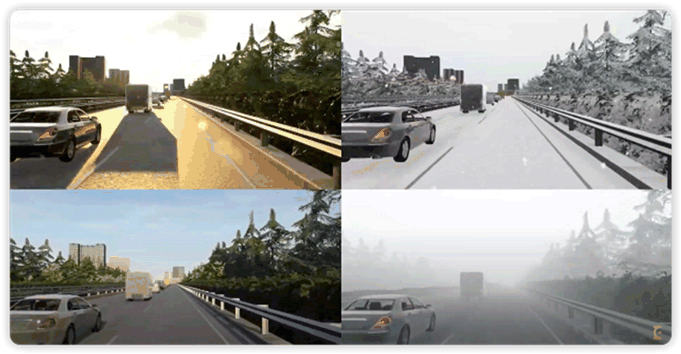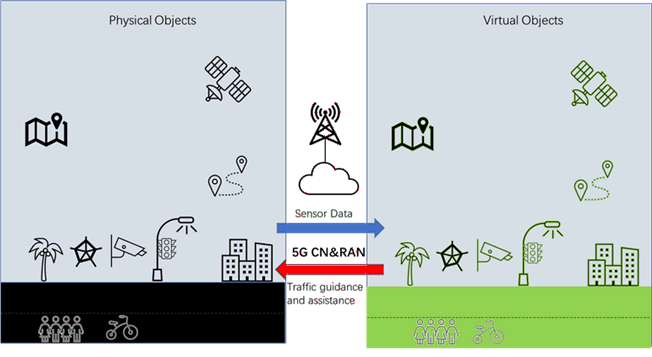Content for TR 22.856 Word version: 19.2.0
1…
5…
5.2…
5.3…
5.4…
5.5…
5.6…
5.7…
5.8…
5.9…
5.10…
5.11…
5.12…
5.13…
5.14…
5.15…
5.16…
5.17…
5.18…
5.19…
5.20…
5.21…
5.22…
5.23…
5.24…
5.25…
5.26…
5.27…
5.28…
6
7…
7.2
8
A
B
C…
5.2 Use Case on Mobile Metaverse for 5G-enabled Traffic Flow Simulation and Situational Awareness
5.2.1 Description
5.2.2 Pre-conditions
5.2.3 Service Flows
5.2.4 Post-conditions
5.2.5 Existing features partly or fully covering the use case functionality
5.2.6 Potential New Requirements needed to support the use case
...
...
5.2 Use Case on Mobile Metaverse for 5G-enabled Traffic Flow Simulation and Situational Awareness p. 17
5.2.1 Description p. 17
Smart transport is a very important area for 5G system as well as an important mobile metaverse service. To reduce traffic jam and minimize traffic accident, 5G, including cellular based V2X technologies becomes more and more essential. The 5G system can be utilized to support real-time information & data delivery for the traffic participants including pedestrians, bicycle riders, and vehicles with or without autonomous driving mode. As shown in Figure 5.2.1-1, the physical objects including road infrastructure and vehicles including cars and trucks in each lanes, will have a corresponding digital twin in the virtual world, and the virtual and physical objects form the mobile metaverse. In this use case, there are virtual objects which actually represent the physical objects including vehicle, road and also pedestrians. This is the basis to enable smart transport applications like traffic flow simulation and situational awareness.

With the support of 5GS, real-time information and data about the physical objects can be delivered and the virtual objects of the road infrastructure and traffic participants including vulnerable road users can form a smart transport mobile metaverse service as shown in Figure 5.2.1-2. Then real-time processing & computing can be conducted to support traffic simulation, situational awareness, and real time path guidance. Real-time safety or security alerts can be generated for vehicles as well as the driver and passengers.

Figure 5.2.1-2: Scenario of 5G-enabled Traffic Flow Simulation and Situational Awareness
(⇒ copy of original 3GPP image)
(⇒ copy of original 3GPP image)
In order to support traffic flow simulation and situational awareness service, the 5G network need to provide low latency, high data rate and high reliability transmission, handover procedures that minimize service disruptions, and in addition, the 5G network may also need to be further enhanced to meet the service requirements for 5G-enabled traffic flow simulation and situation awareness. Meanwhile, in addition to the physical objects which may use UEs for telecommunication services, their corresponding virtual objects are also capable of interacting with each other and also interact with physical objects via 5GS.
This use case employs terminology defined in Table 5.2.1-1.
| Situational Awareness | The ability to know and understand what is going on in the surroundings, e.g. the perception of environmental elements and events |
5.2.2 Pre-conditions p. 19
- Traffic participants may or may not be equipped with 5G-enabled terminal equipment. The 5G-enabled terminal equipment can send and receive data via 5G network.
- Computing and storage resources are provided for the mobile metaverse servers deployed locally or over the data network (in a centralized cloud) to allow real-time processing of huge amount of data produced by human, vehicle, camera, radar etc.
- Wired or wireless communication resources are configured among the road infrastructure and mobile metaverse server so that the server has real time information of traffic participants perceived by these sensors. The road infrastructure include camera, radar/lidar and also other devices, e.g. for traffic control and guidance etc. The infrastructure equipment may have wired connection e.g. fiber or ethernet or any other wired connection if available. The cellular wireless network can be used to provide a more flexible way to obtain communication services, especially when a wired connection is not available.
5.2.3 Service Flows p. 19
- Wired or wireless communication path are configured among the road infrastructure and mobile metaverse server so that the server has real time information of traffic participants perceived by these sensors.
- Sensors deployed in roadside are initialized and enter normal working mode which means the sensors can start to capture the traffic participants.
- Data connections between the vehicle driver's UE and server are established with 5G UE module being registered with the server. Vehicles without driver are equipped with a 5G UE module.
- The traffic participants including pedestrians, bicycle riders, and vehicles, send real-time information towards the server by means of 5G UEs. The real-time status information includes position, speed, direction, brake status etc. Other related status information can be, but is not limited to, sensors for XR (haptic, audio, video, etc) or smart transport (traffic light, camera, radar/LiDAR, etc). These traffic participants are physical objects in physical world which send their property and status information to the corresponding digital-twins objects, that is, virtual objects. This real-time information may include structured and unstructured data. Structured data normally means data which has been processed and thus formatted in a certain way, can be easily stored in database and when transmitted via 5G wireless network, normally less transmission resource (e.g. lower data rate) is needed. Unstructured data are not formatted in a certain and pre-defined way and is not easy to store in database and when transmitting over 5G network, more transmission resource would be needed.
- Within the mobile metaverse service, for 5G-enabled traffic flow simulation and situation awareness, real-time information of the physical objects including the road infrastructure, the traffic participants as well as other information from traffic light signal, camera, radar, etc, are synchronized to the virtual objects and real-time simulation are conducted. The virtual objects can also interact with each other within virtual world and interact with physical objects via 5G system. Having interaction among virtual and physical objects is essential and beneficial to support traffic simulation and situational awareness as the virtual objects can also have their intelligence which allow them to request telemetry from physical objects or other virtual objects. Thus, not only the physical but also virtual objects need to interact via 5G system and they need to be identified. Interaction means the physical objects deliver real-time status data to digital twin i.e. virtual objects in one direction, and the virtual objects can also send alert or other information to physical objects. Such interaction needs to be realized via 5GS because the physical objects like vehicles or humans need to use a 5G UE to access the 5G system and use 5G resources to establish a connection with 5G system QoS support. Identification of these physical and virtual objects by 5GS and thus associating them is needed to support such interaction, meanwhile, from 5G system perspective, this make it easier for the 5G system, based on operator policy with 3rd party, to provide bearer services with corresponding QoS guarantee for both physical and virtual objects as they can be seen as UE for 5GS. It is noted that physical objects may include static and dynamic. Some static objects deployed along road side like light poles may not move but their properties can be synchronized with their virtual objects if such properties may impact traffic simulation and situational awareness and also visualization processing of the physical world. Theses physical objects may or may not have dedicated UEs. Pedestrian and vehicles are equipped with UEs but the sensors like camera, LiDAR and radar may share a common communication module to establish connection with mobile metaverse services. The communication module can be wired node or wireless UE.
- Traffic flow simulation is conducted which can predict whether there will be traffic jam and which path is optimal for a certain vehicle. The simulation can generate traffic assistance or guidance in a real-time manner towards the traffic participants.
- The mobile metaverse server sends the traffic assistance or guidance information to the UE which serves the pedestrian, bicycle rider, vehicle driver or autonomous vehicle.
5.2.4 Post-conditions p. 20
- The mobile metaverse server conducts big data analysis to further refine the accuracy of traffic flow simulation and situation awareness.
- Both UEs serving (e.g. providing sensing data for) the physical objects and digital twins objects can be identified by the 5G system.
5.2.5 Existing features partly or fully covering the use case functionality p. 20
The QoS framework of 5G system supports low latency, high reliability or high data rate transmission of data traffic.
5.2.6 Potential New Requirements needed to support the use case p. 20
[PR 5.2.6-1]
The 5G system shall be able to support the following KPIs for transmission for traffic between a large number of UEs and application server (e.g. mobile metaverse server).
| Use Cases | Characteristic parameter (KPI) | Influence quantity | ||||||
|---|---|---|---|---|---|---|---|---|
| Max allowed end-to-end latency | Service bit rate: user-experienced data rate | Reliability | Area Traffic capacity | Message Data Volume | Transfer Interval | Service Area | ||
| 5G-enabled Traffic Flow Simulation and Situational Awareness | [5-20] ms (NOTE 1) | [10~100 Mbit/s] [25](NOTE 6) | > 99.9% | [~39.6 Tbit/s/km2 ]
(NOTE 5) | Typical data:
Camera: 10M bits/s per sensor (unstructured)
LiDAR: 90M bits/s per sensor (unstructured)
Radar: 10M per sensor (unstructured)
Real-time Status information including Telemetry data:
[< 50K bits/s] per sensor/vehicle/VRU (structured) (NOTE 2) | 20-100 ms
(NOTE 3) | City or Country wide
(NOTE 4) | |
|
NOTE 1:
The mobile metaverse server receives the data from various sensors, performs data processing, rendering and provide feedback to the vehicles and user s. The end-to-end latency refers to the transmission delay between a UE and the mobile metaverse server. Exact value is FFS.
NOTE 2:
To support at least 80 vehicles and 1600 users present at the same location (e.g. in an area of 40m*250m) to actively enjoy immersive metaverse services for traffic simulation and traffic awareness, the area traffic capacity is calculated considering 2 cameras, 2 Radars, 2 LiDARs on road side, 1600 user's smart phones and 80 vehicles with 7 cameras, 4 radar and 2 LiDAR for each vehicle. These application layer message data need to be segmented for network transport thus doesn't mean packet size. The real-time status information including telemetry data may be structured.
NOTE 3:
The frequency considers different sensor types such as Radar/LiDAR (10Hz) and Camera (10~50Hz).
NOTE 4:
The service area for traffic flow simulation and situational awareness depends on the actual deployment, for example, it can be deployed for a city or a district within a city or even countrywide. In some cases a local approach (e.g. the application servers are hosted at the network edge) is preferred in order to satisfy the requirements of low latency and high reliability.
NOTE 5:
The calculation is this table is done per one 5G network, in case of N 5G networks to be involved for such use case in the same area, this value can be divided by N. Exact value is FFS.
NOTE 6:
User experienced data rate refers to the data rate needed for the vehicle or human, the value is observed from industrial practice and exact value is FFS.
|
||||||||